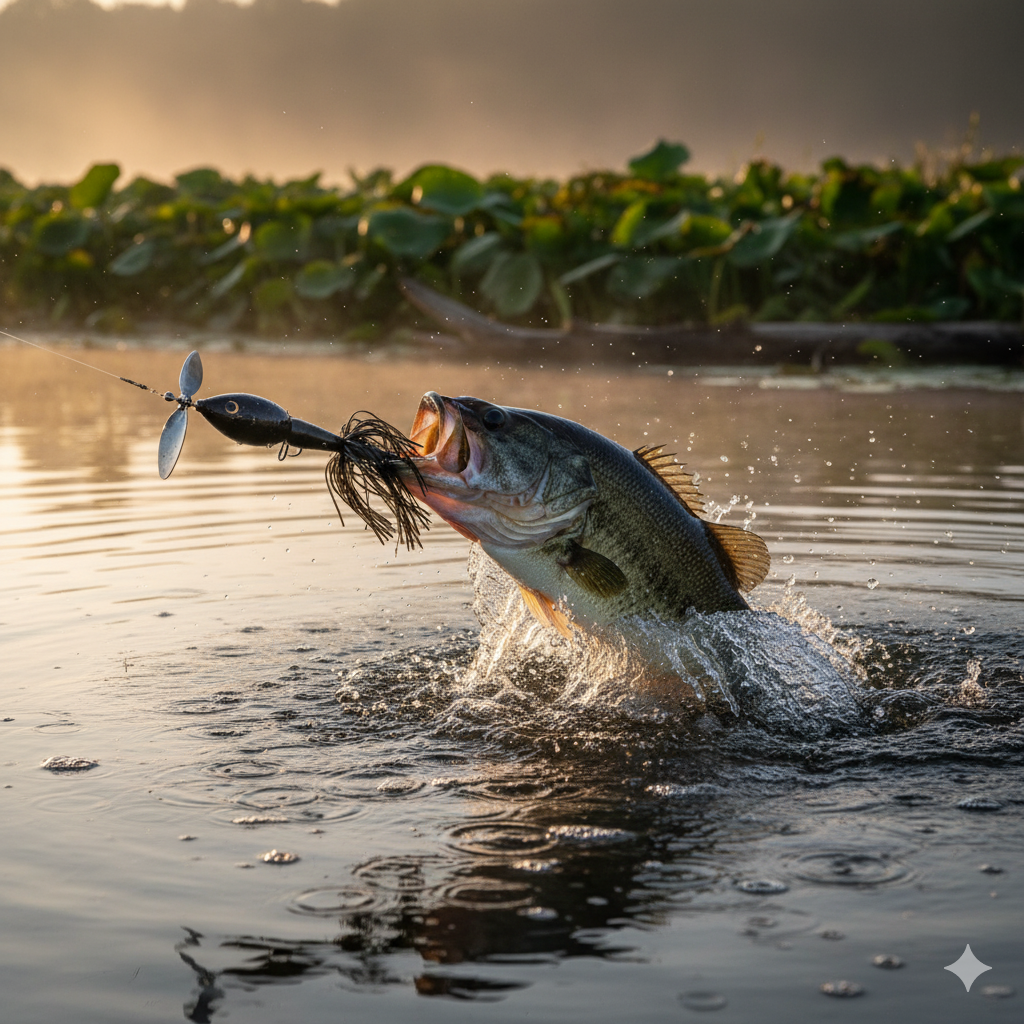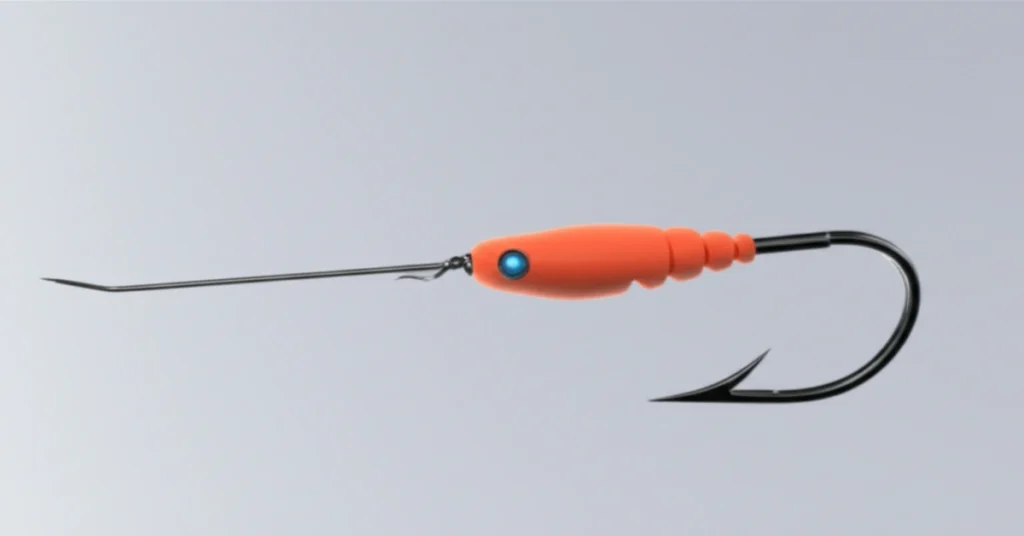The Squeal & The Splash: Your Ultimate Guide to Mastering Buzzbaits for Bass in 2025
The sound of a buzzbait cutting through the surface is a symphony of aggression—a high-pitched squeal followed by a frantic gurgle that drives bass into a frenzy. There are few feelings in fishing more exhilarating than a bass blowing up on a topwater lure. This is your ultimate guide to mastering the art of the buzzbait, unlocking explosive strikes, and landing more lunkers.
Table of Contents
- What Are Buzzbaits?
- Why Buzzbaits are a Bass Angler’s Secret Weapon
- Types of Buzzbaits: Blades, Clackers & More
- When to Use a Buzzbait for Bass
- How to Use a Buzzbait Lure: The Retrieve is Everything
- Essential Gear for Buzzbait Fishing
- Pro Tips & Advanced Buzzbait Tactics
- Frequently Asked Questions About Buzzbaits
What Are Buzzbaits?
A **buzzbait** is a topwater lure consisting of a wire frame, a weighted head, a silicone or living rubber skirt, and a propeller-like blade at the front. The unique design allows the angler to retrieve the lure just on the surface of the water, where the spinning blade creates a loud “buzzing” or “squealing” sound and a turbulent bubble trail. This commotion, combined with the lure’s profile, perfectly imitates a frantic, panicked baitfish or an easy-to-catch critter on the surface, making it an irresistible target for predatory fish like bass. Unlike many other topwater lures, a buzzbait is a **sinking lure**. The key to using it effectively is to begin your retrieve the instant it hits the water to keep it on the surface.
Why Buzzbaits Are a Bass Angler’s Secret Weapon
There are very few lures that can get a bass to strike out of pure instinct and aggression like a buzzbait. They are a staple for anglers everywhere for a reason:
- Unmatched Commotion: The loud squeal and churning water trigger an aggressive reaction strike that fish often can’t resist.
- Excellent for Covering Water: With a fast retrieve, you can quickly and efficiently search large areas to locate active fish.
- Weedless Design: The wire arm and single upturned hook make buzzbaits incredibly weedless, allowing you to fish them over and through shallow cover where other lures would snag.
- Big Fish Lure: The commotion and profile of a buzzbait often entice larger, more territorial bass to strike.
Types of Buzzbaits: Blades, Clackers & More
While all buzzbaits share a basic design, they come in a variety of styles that affect their action and sound. Understanding these differences is key to choosing the right lure for the conditions.
- Standard Single-Blade Buzzbait: The classic, with a single, large blade that produces a consistent, high-pitched squeal. It’s the go-to for most situations.
- Double-Blade Buzzbait: Features two smaller blades for increased flash and a slightly different sound.
- Clacker Buzzbait: Designed with a metal blade that hits the jig head on every rotation, producing a loud, rhythmic “clack-clack-clack” that can draw fish from a distance.
- Blade Variations: Some buzzbaits, like the **Strike King buzzbait**, feature unique blade shapes (e.g., a “Tri-Wing” blade) that create a distinct sound and bubble trail, often with a “Diamond Dust” or glitter finish for added flash.
The Secret of the Black Buzzbait
While natural colors like white and shad patterns are popular, the **black buzzbait** is a consistent producer, especially in specific situations. Black provides a strong silhouette against the sky, making it highly visible to fish looking up. This is particularly effective in low-light conditions (dawn, dusk, and overcast days) and in stained or murky water where a high-contrast profile is needed. Many pros, including Chad Hoover, recommend throwing a **black buzzbait** all day long, regardless of sunlight, as it can trigger aggressive, territorial strikes that other colors won’t.
When to Use a Buzzbait for Bass
Knowing **when to use a buzzbait for bass** is as important as knowing how. Buzzbaits are a warm-water lure that are at their best when water temperatures are above 55°F (13°C) and the fish are actively feeding in the shallows.
- Morning & Evening (Low Light): The most popular and effective time. Bass move shallow to feed on baitfish under the cover of darkness. The buzzbait’s sound is easy for them to track.
- Overcast & Rainy Days: The low light and lack of bright sun create ideal conditions for topwater lures throughout the day.
- Post-Spawn Period: After the rigors of spawning, bass are hungry and will aggressively strike a buzzbait to quickly replenish their energy.
- Over Submerged Vegetation: Their weedless design makes them a top choice for fishing over the tops of submerged grass, hydrilla, and lily pads without snagging.
- Around Wood & Docks: They can be skipped under docks or retrieved parallel to logs, tempting bass out of cover.
How to Use a Buzzbait Lure: The Retrieve is Everything
The core technique for **how to use a buzzbait** is deceptively simple, but mastering the nuances can make all the difference.
- The Instant Retrieve: As mentioned, a buzzbait sinks. You must begin reeling the moment the lure touches the water to keep the blade spinning and the bait on the surface. This is a critical step, especially on a long cast.
- The Steady & Consistent Retrieve: The primary retrieve is a smooth, steady reeling motion. The key is to find the perfect speed that keeps the blade turning and the bait on the surface without it “blowing out” and losing its sound. Vary your speed until you find what the fish want.
- The Stop & Go: On occasion, throwing in a quick pause or burst of speed can trigger a reluctant bass to strike. This mimics an injured baitfish trying to escape.
- The High-Speed Burn: In some situations, especially with aggressive fish, a super-fast retrieve can trigger a reaction strike that a slow retrieve won’t. This works well over open flats or sparse cover.
Essential Gear for Buzzbait Fishing
Using the right equipment is non-negotiable for success with buzzbaits. It’s about power and control for casting, a strong hookset, and handling big fish in heavy cover.
- What rod do you use for buzzbaits? A 7′ to 7’6″ medium-heavy to heavy power baitcasting rod with a fast action tip is ideal. The rod’s backbone is crucial for driving the large, single hook home, while the length provides excellent casting distance. For open water, a longer rod is better. For skipping under docks, a shorter rod may be more manageable.
- Reel: A high-speed baitcasting reel with a gear ratio of 7.1:1 or higher (some anglers prefer 8.1:1 or even 9.1:1) is best. The fast retrieve allows you to get the lure on the surface quickly and keep it there.
- Line: **Braided fishing line** is the top choice. Use a strong braid in the 30- to 65-pound test range. Braid’s zero-stretch properties ensure you can feel the subtlest bite and deliver a solid, powerful hookset from a long distance.
Pro Tips & Advanced Buzzbait Tactics
Take your buzzbait game to the next level with these expert insights, including a look at what pros are throwing.
- Add a Trailer Hook: Bass often swipe at a buzzbait, resulting in a missed hookset. Adding a single trailer hook to the main hook will significantly increase your hook-up ratio.
- Trailer Options: Add a soft plastic trailer like a swimbait or a toad (a frog with paddle feet). A trailer adds bulk and a lifelike profile. A toad trailer in particular can slow down the lure, allowing you to fish it at a slower speed while maintaining its surface action.
- What buzzbait does Jacob Wheeler use? One of the top pros in the world, Jacob Wheeler, uses the **Accent Jacob Wheeler Original Buzzbait**. This lure is designed with an oversized blade that gets it on plane quickly, a molded skirt holder, and a bait keeper barb for securing your plastic trailer.
- Listen to Your Lure: Pay attention to the sound. A loud squeal often means the blade is running perfectly. If it starts to sound “off,” it may be time to tune it by bending the wire arm slightly.
Frequently Asked Questions About Buzzbaits
Q: What’s the difference between a buzzbait and a spinnerbait? A: A buzzbait is a topwater lure designed to run on the surface, while a spinnerbait is a subsurface lure that runs below the surface, featuring one or more spinning blades on a wire arm. Q: What’s the best time to fish a buzzbait? A: The best times are during low-light conditions (dawn, dusk, overcast days) and when the water is warm (above 55°F). You can also use a **black buzzbait** all day in murky water or on sunny days for a high-contrast presentation. Q: Should I add a trailer? A: Yes, absolutely. Adding a soft plastic trailer (like a fluke or a toad) can enhance the lure’s profile, action, and hook-up ratio. It also allows you to retrieve the lure at a slower speed while keeping it on the surface.
Conclusion: The Ultimate Topwater Thrill
The buzzbait is a simple, yet incredibly effective lure that delivers some of the most exciting strikes in fishing. Its unique blend of sound, surface commotion, and weedless design makes it a must-have for any angler targeting aggressive predators. By knowing when to use it, how to work it, and what gear to pair it with, you’ll be able to tap into its full potential and experience the heart-stopping thrill that only a topwater explosion can deliver.
Ready to add more buzz to your fishing? Grab a **Strike King buzzbait** or a **black buzzbait**, head to your favorite stretch of water, and prepare to be amazed!
Related Guides:
- Topwater Tactics: The Thrill of the Surface Strike
- Mastering Spinnerbaits: An Essential Guide
- Essential Braid-to-Fluoro Knots Every Angler Needs to Know
- Bass Fishing 101: Tips & Techniques
What’s your go-to buzzbait setup? Share your biggest buzzbait catches and your secret tips in the comments below!



